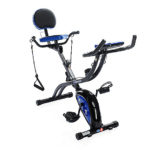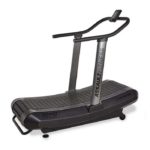Recent Posts
Skiing Vs Snowboarding: Differences
25th July 2023Best Tips For Fishing: Beginners and Intermediate Fishers
25th July 2023Cycling Safety Measures and Best Practices
16th July 2023Benefits Of Cycling For Physical and Mental Health
15th July 2023
You will get to know the step to do a squat with a proper technique. This is an exercise that must be done correctly to be effective without causing injury, so there are many points to memorize and apply. Take the time to familiarize yourself with the movement and gain confidence in yourself before starting to increase your weight on the bar.
1 Have a perfect bar grip width
The step you need to take is put yourself in front of the bar, placed in a rack, and hold it with your two hands. If in case you are tall or you have bad shoulder mobility, you will probably have to grab the bar a bit wide. However, if you have proper external shoulder rotation, it is advisable to put your hands very close to your shoulders. Because The closer your hands are to your shoulders, the more you will be able to put your chest forward and also the more you will lock your upper body.
2 Position under the bar, shoulders backward
The moment you are in front of the bar, and your hands are very placed on the bar with a width that fits you, the next thing to do is to get under the bar. Pull yourself towards the bar, thinking to tighten your shoulder blades, as if you wanted to hold a coin between the two.
doing this, you will be able to compress your trapezius, and you will have a higher muscle thickness to rest the bar comfortably on your shoulders. Try to squat without foam on the bar, because if you get used to this comfort accessory you will not be able to do without it and you will not be able to do squats bar naked without experiencing pain.
3 Pull elbows forward to the chest
The next phase is to bring your chest forward. You must try to move your torso as far ahead as possible, bulging your rib cage. To ensure your chest is well positioned, you must turn your elbows down below the bar and place your forearms to be vertical. follow this procedure will allow you to lock your upper body and make sure you keep your spine in a neutral position.
4 Push aggressively on the bar
Now that your upper back is closed, you must push slowly on the bar with your two hands to pressure against your body. This will enable you to “dominate” the bar before leaving the rack. you must be aggressive and block making use of the bar so that the weights do not tip over the sides. If you are not bold, do not attempt to push hard on the bar before exiting the rack, the bar will feel more substantial.
5 Exit the rack
Now you are very tight against the bar with your back well locked; it is highly the time to exit the rack bar. all you need to do is to Take a deep breath, and stop breathing for a moment, press the bar to lift it and take it out of the rack. Stay in place and wait for the weight to stabilize before moving back. Once the bar is maintained, you can go back one or two steps.
6 Position your feet well
the moment you get out of the rack, you must position your feet in a comfortable position. If you have large legs and a short torso, you will probably prefer a place with your feet apart, and if you feature short legs and a long torso, you will prefer a spot with tighter feet. Try to find the location that fits you best and stick to it every time.
The angle between your both feet will also vary base on their spacing. you should know that the tighter your feet are, and the more the angle between your feet closed, and the more your feet will spread apart, the more you have to open the angle between your feet. If you cover your feet parallel to them, you will have more trouble going down profoundly and cool. In any case, make sure you quickly find your foot position when you go exit the rack, so not to lose more energy when you lift heavy loads.
7 Move the weight on the back and the outside of the feet
Once out of the rack and with your feet firmly in place, you must make sure that the weight of the bar is well on the back and outside of your feet. Feel your ground support at the level of your heels and not your toes. You must be able to lift your toes throughout the squat movement without losing balance. Do not put too much weight to the back of your heels at the risk of tipping back. This is very important for lifting heavy loads, so be sure to properly spread the weight on the back of your feet even with small loads to familiarize yourself with this principle.
8 Check his position before squatting
Now that you are ready to squat, you must check all the previous points to ensure your body is in the right place. You need to focus on having your chest pulled forward, and the bar pressed against your body. Take a deep breath out your chest and pull your elbows down. Your neck should also be in a neutral position throughout the movement; you should not pull your head backward.
9 Fix your gaze on a point
Find a spot in front of you slightly above the level of your eyes, where you will be watching throughout the movement. If you squat in front of a mirror, you will tend to look down to admire your legs and check if your technique is proper. The problem is that your body tends to follow your eyes and to look down, you will favor your head and your chest to look down rather than up. Looking down, you will break your balance, and you will have more trouble making your recovery.
10 Take a big breath
At an athletic strength competition, you will always see the competitors take a deep breath just before performing their squat. When you inhale deeply and block your breathing before squatting, you will increase intra-abdominal and intra-thoracic pressure. This pressure inside your body will increase your rigidity and stabilize your spine. To be completely capable, you must breathe with both the belly and the chest to support the upper and lower parts of your spine.
11 Now is the time to Squatter
To start the movement, you have to move your knees outwards and push your buttocks backward. By doing this you will activate the muscles of your hips and make sure you keep your ankles, your femur, and your knees in proper alignment, you will also be able to go lower without rounding your back. When squatting, it is essential that your knees always move in the axis of your feet and never go inwards.
During the descent, you should also keep your chest well out and your abs tight to ensure that your back stays upright. You do not have to go down until your buttocks “touch the ground,” so going down till your thighs are straightly parallel to the floor is enough to activate all the muscles in your legs properly. When you down avoid using the rebound to go up, make a very brief stop to ensure your stability before starting the recovery.
12 The improvement was the supreme effort
The moment you are at the bottom of the movement, you should not think about standing up, but instead pulling the bar with your hands as much as you can, it will help you to climb up vertically. When we first think of getting up, we tend to tip slightly forward, which moves the center of gravity and suddenly we find ourselves to push with the tips of the feet rather than with the heels. After having pushed the bar with your hands, you must then think of moving your knees outward and start to climb up by pushing your back towards the back. Remember to drive on the bar and spread your knees outward throughout the recovery.
13 Squat completed
That’s if you did a perfect squat, take your breath, and repeat all these steps on all of your rehearsals. Firstly, you will have to focus first on your technique, and over time, everything will become automatic, and you will be ready to quickly increase your strength and muscle mass effectively and without hurting yourself.
Recent Posts
Techniques and Best Practices for Anglers
21st November 2023Hiking Vs Trekking: Differences and Similarities
12th August 2023How to Lose Weight by Cycling
12th August 2023How to Choose Skis for Beginners
12th August 2023Related Articles
Types of Hiking Trails: Options to Explore
Hiking captures the hearts of people across ages and fitness levels as...
By Fortunatus Adunola25th July 2023Benefits Of Cycling For Physical and Mental Health
Cycling, a broadly embraced hobby, brings forth manifold blessings for each physical...
By Fortunatus Adunola15th July 20235 proven strategies to teach your child skiing.
It’s done, your holidays in the mountains are reserved! To you, the...
By O. Johnson Taiwo11th June 2019Five Activities To Do With Children
Going skiing with kids can often be stressful for parents. But do...
By O. Johnson Taiwo11th June 2019














